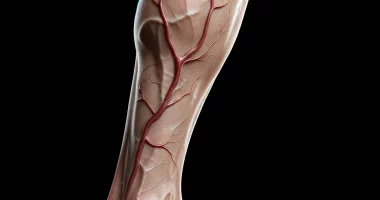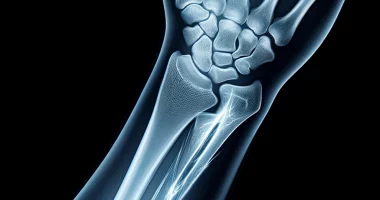Congenital aortic stenosis
General information
Congenital aortic stenosis is a congenital heart defect in which the aortic valve flaps are fused. The incidence of the malformation ranges from 2% to 8% among all CHD and 2.5% among all critical conditions in newborns. Previously, surgery was the mainstay of treatment for patients with aortic valve stenosis. Since transluminal balloon valvuloplasty was proposed for treating aortic valve stenosis in 1983, the method has become the operation of choice in newborns, including those in critical condition. In aortic valve stenosis, the left ventricle cannot adequately maintain the cardiac output necessary for everyday life activity. If the compensatory capacity of the left ventricle is insufficient, severe congestive heart failure develops, which is fatal without emergency surgical intervention.
What is congenital valve stenosis?
Congenital aortic valve stenosis is an anatomic defect that occurs during intrauterine development. The aortic valve is located between the outlet of the left atrium and the aorta. Its function is to prevent blood backflow during diastole (the phase when the heart muscle relaxes and prepares for the next contraction). Disruption of the anatomical structure of the valve lobes can lead to a significant narrowing of the outlet from the left atrium to the aorta, causing severe hemodynamic disorders and irreversible changes.
In the presence of congenital valve stenosis, it is difficult for the required volume of blood to pass through the narrowed valve ring during a heartbeat. The left ventricle of the heart is put under additional strain in an attempt to compensate for the heart failure. In response to the difficulty in ejecting blood, hypertrophy of the left ventricle’s myocardium (muscle layer) develops. Even though the increased force of contraction can maintain a sufficient volume of blood circulation for some time, the heart suffers from chronic overload, which sooner or later leads to the depletion of its reserves and the progression of the disease. In the decompensation stage, there is a decrease in contractility and progression of heart failure, predominantly in the left heart.
Clinical presentation of congenital aortic valve stenosis
The symptoms of congenital valve stenosis are primarily determined by the degree of valve narrowing. In severe cases, symptoms of heart failure jeopardize the newborn’s life and require emergency, highly qualified medical care. Compensated defects limit the child’s physical capabilities, leading to increased fatigue, weakness, shortness of breath, and fainting. There is often a delay in physical development.
Mild stenosis may occur without significant clinical signs until adolescence, when intensive growth, including of heart tissues, is noted. The deformed aortic valve ring cannot increase proportionally, so the typical symptoms of thismalformation increase. The compensatory capacity of the heart at this age is severely limited by the load of the intensively growing body, which can lead to rapid progression of heart failure.
Diagnosis of congenital valve stenosis
Congenital valve stenosis is suspected during physical examination. When auscultation of the heart, a characteristic murmur is determined, arising due to intense blood flow in the place of pathological narrowing. To confirm the assumptions of cardiologists, modern methods of instrumental diagnostics can be used, including:
- Ultrasound examination of the heart – echocardiography. This non-invasive method is profiling in the diagnosis of congenital heart disease.
- Electrocardiography (ECG) and methods of continuous observation of the electrophysiologic function of the heart (monitoring)
- Exercise testing (ergometry) is used to diagnose cardiac muscle reserve
- Chest radiography to determine the state of the mediastinal organs and secondary changes caused by the malformation
- Computed tomography and magnetic resonance imaging help to identify the smallest anatomical changes in the damaged valve
If necessary, the cardiology department also performs an invasive study – catheterization. The method allows not only to diagnose valve stenosis but also to perform reconstructive intervention.
Surgery for congenital aortic valve stenosis
Conservative treatment of congenital aortic valve stenosis can only maintain heart function for a limited period. Surgical treatment is the most effective and can be performed on patients of any age.
The following types of surgery are most commonly performed for congenital valve stenosis:
- Aortic valve replacement with a mechanical or biological graft is an open-heart surgery that restores the valve’s anatomical shape and functional capacity. Cardiac surgeons favor high-quality biological grafts, which reduce the risk of thrombosis on the valve leaflets and do not require continuous anticoagulants. In some cases Ross operation can be done – a surgical procedure involving the replacement of a patient’s diseased aortic valve with their own pulmonary valve, and subsequently replacing the pulmonary valve with a donor valve.
- Transcatheter aortic valve replacement (TAVI). This innovative minimally invasive cardiac surgery technique allows for reconstruction or complete valve replacement without open-heart surgery. The catheter-assisted procedure reduces the likelihood of complications and significantly shortens the postoperative rehabilitation period.
- Balloon dilation of the narrowed aortic valve annulus. This minimally invasive intervention is most effective in children (the valve tissues in childhood are highly elastic, whereas a balloon-dilated valve of an adult patient quickly acquires its primary shape). The procedure is performed by cardiac catheterization and can serve as an effective alternative to cavity surgery in mild forms of stenosis or as a temporary solution during patient preparation before aortic valve replacement.
- Valve-preserving surgery (surgical annuloplasty) is possible for minor aortic valve defects. This operation aims to preserve the structures of the natural valve and restore its function fully. The procedure is often used in children with fused valve flaps.
Endovascular methods – balloon valvuloplasty – successfully treat critical aortic valve stenosis. The essence of the operation is that using the femoral artery as an access through the stenosed aortic valve into the left ventricular cavity, a conduit is inserted into the left ventricle cavity, and then a balloon catheter is inserted through it, which is subsequently inflated and ruptures the cross-linked aortic valve flaps. The duration of the operation is at most 1 hour. Newborn patients are operated on under general anesthesia, and older patients – under IV sedation. Currently, the operation is accompanied by low mortality and several complications.
Balloon valvuloplasty of aortic valve stenosis in newborns is indicated in the presence of symptoms of circulatory insufficiency, poorly corrected by drug therapy and peak systolic pressure gradient between the left ventricle and aorta> 50 mmHg.
Contraindications to balloon dilatation of aortic stenosis include:
- 1. Aortic valve insufficiency of more than 2 degrees.
- 2. Mono-valvular aortic valve.
- 3. Participation of mitral valve structures in forming left ventricular outflow tract obstruction.
- 4. Left heart and aortic hypoplasia syndrome.
- 5. Infective endocarditis.
The operating physician, a specialist in X-ray endovascular diagnostics and treatment, decides whether to perform balloon valvuloplasty each time.
All these treatment options are available in more than 520 hospitals worldwide (https://doctor.global/results/diseases/congenital-aortic-stenosis). For example, Ross procedure can be done in 22 clinics across Turkey for an approximate price of $18.4 K (https://doctor.global/results/asia/turkey/all-cities/all-specializations/procedures/ross-operation).

